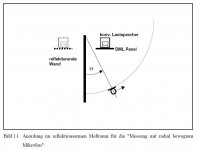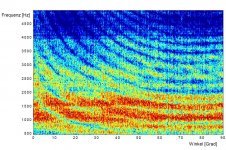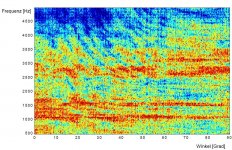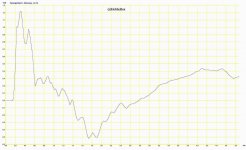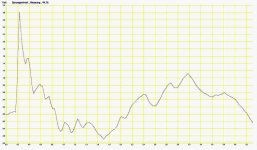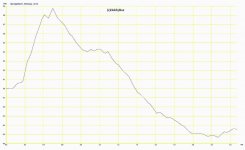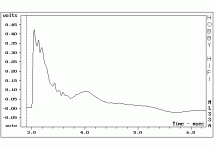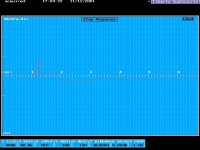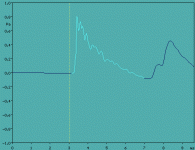Interestingly the vibrational modes of the crash cymbal look very
similar to that of the "Manger" transducer e.g.
Why not use a crash cymbal as a loudspeaker membrane ?
To achieve a balanced response of a bending wave transducer, the modal
density - the number of modes in a given frequency interval - has to be
much higher in a good bending wave transducer than in most musical
instruments.
A musical instrument has typically a low number of high Q resonances in
a given frequency interval, while in a bending wave tranducer we ask for
a high number of resonances having also a lower Q.
Depending on the Q of the resonances and their distribution over frequency,
it is widely held as a rule of thumb, that a bending wave transducer
should have at least 10 modes per octave, to make a balanced response
possible. A mode is a vibrational pattern spreaded along the membrane
area of the transducer. Every mode is associated to a certain resonant
frequency af the system.
Instead of trying to avoid resonance, the design of a bending wave
transducer is about increasing the number of modes to make the device
behave "statistical" by modal overlap:
Once the modal overlap is high enough, there is no resonant behavior
audible.
I explain a bending wave transducer sometimes to myself as some kind of
"universal" musical instrument. If the modal density and further acoustical
properties are chosen well, it is able to "emulate" existing musical instruments:
An observed vibrational mode of our crash cymbal e.g. or a violin to be reproduced,
falls into a frequency range, where a whole set of modes of the bending
transducer is excited. If built well, the characteristic spectral power
distribution of the instrument can be approximated very closely.
To achieve this, it is not necessary for the vibrational modes itself to
look similar to those of the instrument to be reproduced. What matters is -
like for conventional loudspeakers too - a balanced frequency response of
the radiated sound pressure and the acoustic output power.
similar to that of the "Manger" transducer e.g.
Why not use a crash cymbal as a loudspeaker membrane ?
To achieve a balanced response of a bending wave transducer, the modal
density - the number of modes in a given frequency interval - has to be
much higher in a good bending wave transducer than in most musical
instruments.
A musical instrument has typically a low number of high Q resonances in
a given frequency interval, while in a bending wave tranducer we ask for
a high number of resonances having also a lower Q.
Depending on the Q of the resonances and their distribution over frequency,
it is widely held as a rule of thumb, that a bending wave transducer
should have at least 10 modes per octave, to make a balanced response
possible. A mode is a vibrational pattern spreaded along the membrane
area of the transducer. Every mode is associated to a certain resonant
frequency af the system.
Instead of trying to avoid resonance, the design of a bending wave
transducer is about increasing the number of modes to make the device
behave "statistical" by modal overlap:
Once the modal overlap is high enough, there is no resonant behavior
audible.
I explain a bending wave transducer sometimes to myself as some kind of
"universal" musical instrument. If the modal density and further acoustical
properties are chosen well, it is able to "emulate" existing musical instruments:
An observed vibrational mode of our crash cymbal e.g. or a violin to be reproduced,
falls into a frequency range, where a whole set of modes of the bending
transducer is excited. If built well, the characteristic spectral power
distribution of the instrument can be approximated very closely.
To achieve this, it is not necessary for the vibrational modes itself to
look similar to those of the instrument to be reproduced. What matters is -
like for conventional loudspeakers too - a balanced frequency response of
the radiated sound pressure and the acoustic output power.
Last edited:
Some examples for manufacturers of bending wave loudspeakers:
Transducers based on wave propagation on thin foil
Manger Schallwandler
Airfoil Loud Speakers
Conical shaped membrane driven at the apex
Ohm Speakers
German Physiks - High End Technology Loudspeaker Manufactur - DDD Driver - Home
Flexurally (more or less) rigid flat panels
TERRA-SP3000 of Teragaki-Labo?????????????????TERRA???????????
Welcome to GÖBEL - Revolutionary Bending Wave Technology
NXT Sound - Home
http://futuremusic.com/blog/2007/12...ases-podium-1-flat-panel-audiophile-speakers/
Special case
MBL - Unique High End Audio
I assume bending here is only intended for the lowest mode,
higher order modes seem to be circumvented by using smaller
membranes for higher frequencies. So these may not be
"bending wave speakers" in the same way as the examples
mentioned above.
Transducers based on wave propagation on thin foil
Manger Schallwandler
Airfoil Loud Speakers
Conical shaped membrane driven at the apex
Ohm Speakers
German Physiks - High End Technology Loudspeaker Manufactur - DDD Driver - Home
Flexurally (more or less) rigid flat panels
TERRA-SP3000 of Teragaki-Labo?????????????????TERRA???????????
Welcome to GÖBEL - Revolutionary Bending Wave Technology
NXT Sound - Home
http://futuremusic.com/blog/2007/12...ases-podium-1-flat-panel-audiophile-speakers/
Special case
MBL - Unique High End Audio
I assume bending here is only intended for the lowest mode,
higher order modes seem to be circumvented by using smaller
membranes for higher frequencies. So these may not be
"bending wave speakers" in the same way as the examples
mentioned above.
Last edited:
When looking at the manifold of possibilities in designing
bending wave transducers, there seems to be only one thing
in common:
Radiation of sound by a membrane able to modal vibration.
A classification of a given bending wave transducer could
be according to
Generation of driving force
... dynamic, piezolectric ...
Shape of the coupling area to the membrane
... small circular area, ring, line ...
Number of actuators (exciters) driving the membrane
... single actuator, multiple actuators, muliple actuators but differing in transmitted frequency range ...
Kind of membrane due to form
... flat rectangular, flat circular, high/low aspect ratio, curved ...
Kind of membrane due to material properties
... rigid, soft (correlates with propagation speed of bending waves and coincidence frequency* ) ...
Ability to whole body motion
... whole body motion at low frequencies, modal behaviour only ...
and so on.
None of those design desicions make the transducer good or bad in itself.
But every decision has implications for its properties like
- efficiency
- usable frequency range
- size needed for sufficient modal density
...
Examples for historic roots of bending wave loudspeakers:
- 1929 Patent for exciting a showcase to transmit music and speech for advertising.
If you klick on "Volldokument laden" button on top right you can view the full
document including figures, which are quite self explaining.
http://depatisnet.dpma.de/DepatisNe...tent=treffer&action=pdf&docid=DE000000465189A
- 1924 (about) "Ibach Tonspiegel", "Sound Mirror" named Transducer from the german piano manufacturer Ibach.
This device also has been patented.
Tonspiegel Radio Ibach, Berlin W
Not to mention the traditional knowledge of instrument makers,
which can at least partially be applied to bending wave
lousdpeakers. The "Tonspiegel" is an early example for that
kind of knowledge transfer.
-------------------------
* Since the propagation speed of bending waves on the membrane rises with
frequency due to dispersion, there is a frequency for each membrane where
the propagation speed of bending waves equals the speed of sound in air.
At coincidence and above the efficiency of a bending wave transducer is
higher than below. Some concepts have a coincidence frequency
above the upper frequency limit of hearing (e.g. Manger) and some within.
bending wave transducers, there seems to be only one thing
in common:
Radiation of sound by a membrane able to modal vibration.
A classification of a given bending wave transducer could
be according to
Generation of driving force
... dynamic, piezolectric ...
Shape of the coupling area to the membrane
... small circular area, ring, line ...
Number of actuators (exciters) driving the membrane
... single actuator, multiple actuators, muliple actuators but differing in transmitted frequency range ...
Kind of membrane due to form
... flat rectangular, flat circular, high/low aspect ratio, curved ...
Kind of membrane due to material properties
... rigid, soft (correlates with propagation speed of bending waves and coincidence frequency* ) ...
Ability to whole body motion
... whole body motion at low frequencies, modal behaviour only ...
and so on.
None of those design desicions make the transducer good or bad in itself.
But every decision has implications for its properties like
- efficiency
- usable frequency range
- size needed for sufficient modal density
...
Examples for historic roots of bending wave loudspeakers:
- 1929 Patent for exciting a showcase to transmit music and speech for advertising.
If you klick on "Volldokument laden" button on top right you can view the full
document including figures, which are quite self explaining.
http://depatisnet.dpma.de/DepatisNe...tent=treffer&action=pdf&docid=DE000000465189A
- 1924 (about) "Ibach Tonspiegel", "Sound Mirror" named Transducer from the german piano manufacturer Ibach.
This device also has been patented.
Tonspiegel Radio Ibach, Berlin W
Not to mention the traditional knowledge of instrument makers,
which can at least partially be applied to bending wave
lousdpeakers. The "Tonspiegel" is an early example for that
kind of knowledge transfer.
-------------------------
* Since the propagation speed of bending waves on the membrane rises with
frequency due to dispersion, there is a frequency for each membrane where
the propagation speed of bending waves equals the speed of sound in air.
At coincidence and above the efficiency of a bending wave transducer is
higher than below. Some concepts have a coincidence frequency
above the upper frequency limit of hearing (e.g. Manger) and some within.
Last edited:
This chapter briefly summarizes the internal physics and the
"in room behaviour" of panel type distributed mode loudspeakers.
Loudspeaker and headphone handbook - Google Bücher
------------
"The Loudspeaker and Headphone Handbook", John Borwick, Focal Press
Third edition 2001
Chapter 4 "The Distributed Mode Loudspeaker" by Graham Bank
"in room behaviour" of panel type distributed mode loudspeakers.
Loudspeaker and headphone handbook - Google Bücher
------------
"The Loudspeaker and Headphone Handbook", John Borwick, Focal Press
Third edition 2001
Chapter 4 "The Distributed Mode Loudspeaker" by Graham Bank
Last edited:
Summarized and translated excerpt from an study conducted by NXT:
The pictures show a comparison in interaction
of direct and reflected sound between a panel type
bending wave loudspeaker and a conventional 2-way loudspeaker.
Both speakers were positioned about 50cm from a wall.
A moving microphone like shown in figure 11 was used
for measurement of sound pressure as a function of angle.
2-way loudspeaker: 10cm cone bass-midrange unit and 19mm dome tweeter
Panel loudspeaker: 58cm x 66cm, carbon cover on aluminium honeycomb core
The main radiation axis of both speakers was parallel to the wall.
Signal used was white noise.
x-axis shows angle between microphone and the wall
y-axis shows frequency
color shows sound pressure level
The strong interference of direct and reflected sound field caused by the
conventional speaker is visible in figure 12 by angle dependent dark cues
in the sonagram.
The panel type bending wave loudspeaker in figure 13 shows less comb filtering,
which is due to far lower correlation between direct and reflected sound.
------------------------------
All 3 figures (downsized) were taken from:
"DML - Distributed Mode Loudspeaker
Ein neuer Schallwandler,akustische Eigenschaften und
die Konsequenzen für den praktischen Einsatz" (Original title)
by Charalampos Ferekidis
Own translation of title:
"DML - Distributed Mode Loudspeaker
A new transducer, acoustic poperties and
consequences for practical use"
Link to the article in german language:
http://www.wvier.de/texte/NXT_Tonmeistertagung.pdf
The pictures show a comparison in interaction
of direct and reflected sound between a panel type
bending wave loudspeaker and a conventional 2-way loudspeaker.
Both speakers were positioned about 50cm from a wall.
A moving microphone like shown in figure 11 was used
for measurement of sound pressure as a function of angle.
2-way loudspeaker: 10cm cone bass-midrange unit and 19mm dome tweeter
Panel loudspeaker: 58cm x 66cm, carbon cover on aluminium honeycomb core
The main radiation axis of both speakers was parallel to the wall.
Signal used was white noise.
x-axis shows angle between microphone and the wall
y-axis shows frequency
color shows sound pressure level
The strong interference of direct and reflected sound field caused by the
conventional speaker is visible in figure 12 by angle dependent dark cues
in the sonagram.
The panel type bending wave loudspeaker in figure 13 shows less comb filtering,
which is due to far lower correlation between direct and reflected sound.
------------------------------
All 3 figures (downsized) were taken from:
"DML - Distributed Mode Loudspeaker
Ein neuer Schallwandler,akustische Eigenschaften und
die Konsequenzen für den praktischen Einsatz" (Original title)
by Charalampos Ferekidis
Own translation of title:
"DML - Distributed Mode Loudspeaker
A new transducer, acoustic poperties and
consequences for practical use"
Link to the article in german language:
http://www.wvier.de/texte/NXT_Tonmeistertagung.pdf
Attachments
Last edited:
Example step responses from own earlier prototypes.
Not directly comparable to each other due to varying conditions.
Not directly comparable to each other due to varying conditions.
Attachments
Last edited:
Interview with Paul Paddock, developer of the "Airfoil"
loudspeaker ...
Stereophile: Impact Airfoil 5.2 loudspeaker system
loudspeaker ...
Stereophile: Impact Airfoil 5.2 loudspeaker system
These large rubanoids are bending wave transducers too:
µ¨ÒÕÐù[Tubebbs]ÂÛ̳¼¯Èº - Powered by Discuz! Board
µ¨ÒÕÐù[Tubebbs]ÂÛ̳¼¯Èº - Powered by Discuz! Board
White paper describing the Naim "Ovator" which uses
a wideband "Balanced Mode Radiator" (BMR):
http://www.music-line.biz/cms/fileadmin/pdf/wp_ovator_bmr.pdf
a wideband "Balanced Mode Radiator" (BMR):
http://www.music-line.biz/cms/fileadmin/pdf/wp_ovator_bmr.pdf
Bending Wave Loudspeakers
Is a history of these devices going back to Ernst Chladni (1756–1827) in order?
Ernst Chladni - Wikipedia, the free encyclopedia
This following speaker company is interesting, but they are very short on illustrating the actual audio transducer, so I guess it's just Voodoo and Magic at work.
Video: Göbel bending wave loudspeakers
YouTube - Göbel bending wave loudspeakers
Homepage:
Welcome to GÖBEL - Revolutionary Bending Wave Technology
Göbel Audio mit Detaille Biegewellen-Lautsprecher | HiFi Heimkino News
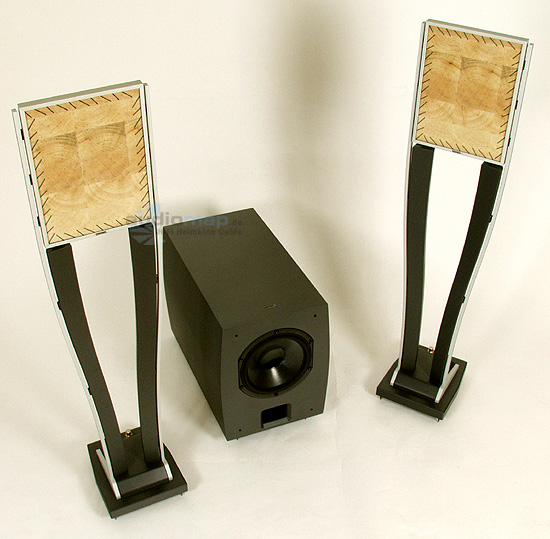
http://www.moxtone.com/2010 High End Show Munich.htm
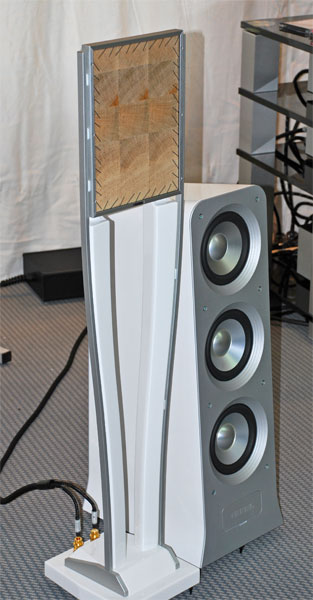
.............................................................
I never really understood this one (2009 patent), do any of you?
Bending wave acoustic radiator
United States Patent 7120263
Bending wave acoustic radiator - Patent 7120263
Is a history of these devices going back to Ernst Chladni (1756–1827) in order?
Ernst Chladni - Wikipedia, the free encyclopedia
This following speaker company is interesting, but they are very short on illustrating the actual audio transducer, so I guess it's just Voodoo and Magic at work.
Video: Göbel bending wave loudspeakers
YouTube - Göbel bending wave loudspeakers
Homepage:
Welcome to GÖBEL - Revolutionary Bending Wave Technology
Göbel Audio mit Detaille Biegewellen-Lautsprecher | HiFi Heimkino News

http://www.moxtone.com/2010 High End Show Munich.htm

.............................................................
I never really understood this one (2009 patent), do any of you?
Bending wave acoustic radiator
United States Patent 7120263
Bending wave acoustic radiator - Patent 7120263
Last edited:
Audio Archives | Travel Gadgets | Travelizmo
MIRAE
Untitled Document
applying the world Patent on 2004
An externally hosted image should be here but it was not working when we last tested it.
Thin Film Speaker MP-C100 by Mirae Plasma
October 10, 2005 | Audio
Mirae-Plasma-Thin-Film-Speaker-MP-C100.JPG
This new approach to plasma viewing comes complete with TFT-columns, made of a thin film-like material and is the latest technology in speaker sound. Film Speakers are transparent as glass and can accept any kind of quality and intensity of sound depending on the form. The large window is said to be constructed from materials found in LCD screens. Other pro's include that they are light and save space, can be manufactured with a variety of designs, and are easy to produce. For more information on film speakers compared with the conventional speaker check out Miraeplasma.
Mirae Plasma MP-C100 "Plasma Speaker" (Ubergizmo)
MIRAE
Untitled Document
An externally hosted image should be here but it was not working when we last tested it.
applying the world Patent on 2004
Last edited:
Audio Spotlight - Add sound and preserve the quiet.
Audio Spotlight® transducer
First found here:
http://www.physicsforums.com/showthread.php?t=270894
An externally hosted image should be here but it was not working when we last tested it.
Audio Spotlight® transducer
Each speaker panel is only 1/2" (1cm) thick, making installation simple.
First found here:
http://www.physicsforums.com/showthread.php?t=270894
An externally hosted image should be here but it was not working when we last tested it.
co axials VS Components
http://www.techchee.com/2009/04/29/super-thin-flat-flexible-loudspeakers/
Distributed Mode Speaker
http://www.digitalsignageeurope.com/content/wired-sound
http://www.ipadforums.net/ipad-general-discussions/9944-how-do-these-sound-boxes-make-sound.html
http://www.freepatentsonline.com/7187776.html
http://www.quadesl.com/quad_esl63.html
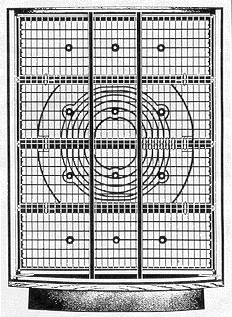
http://www.freepatentsonline.com/6622817.html
http://www.yankodesign.com/2010/07/30/snowflake-speaker/
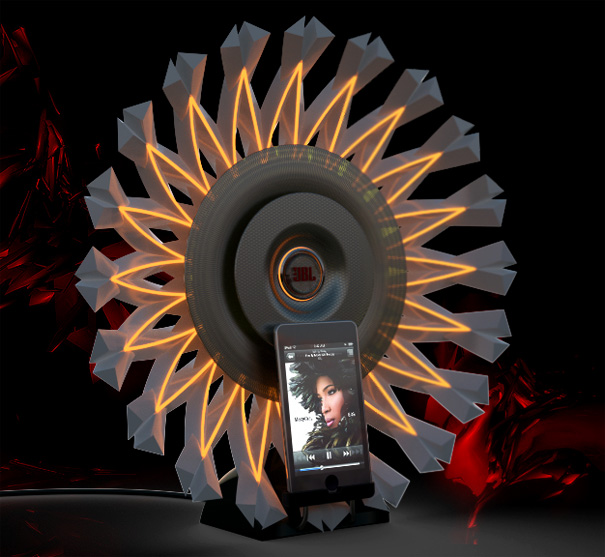
http://www.partyvibe.com/forums/sound-engineering/27792-how-build-sound-system.html
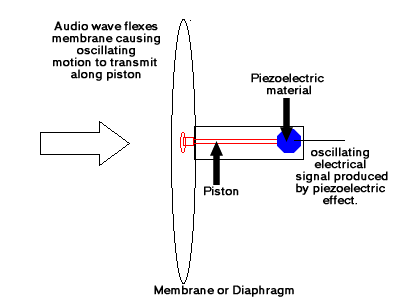
An externally hosted image should be here but it was not working when we last tested it.
http://www.techchee.com/2009/04/29/super-thin-flat-flexible-loudspeakers/
An externally hosted image should be here but it was not working when we last tested it.
Distributed Mode Speaker
http://www.digitalsignageeurope.com/content/wired-sound
An externally hosted image should be here but it was not working when we last tested it.
An externally hosted image should be here but it was not working when we last tested it.
http://www.ipadforums.net/ipad-general-discussions/9944-how-do-these-sound-boxes-make-sound.html
An externally hosted image should be here but it was not working when we last tested it.
http://www.freepatentsonline.com/7187776.html
An externally hosted image should be here but it was not working when we last tested it.
http://www.quadesl.com/quad_esl63.html

http://www.freepatentsonline.com/6622817.html
An externally hosted image should be here but it was not working when we last tested it.
http://www.yankodesign.com/2010/07/30/snowflake-speaker/

Technically the design is simple to execute by integrating the latest in flat membrane audio technology hiding all the electronics in the bottom of the speaker.
http://www.partyvibe.com/forums/sound-engineering/27792-how-build-sound-system.html

Last edited:
P Waves
Observe animations of earthquake waves.
Do it.
So of all the speakers posted, which ones go in which category?
A: Parallel
B: Perpendicular
I first found this topic here: Waves Basics
http://esfscience.wordpress.com/category/physics/page/2/
Observe animations of earthquake waves.
Click the images to see the animations. Play both movies at the same time to examine the relative speeds of the waves.
Do it.
So of all the speakers posted, which ones go in which category?
A: Parallel
B: Perpendicular
I first found this topic here: Waves Basics
http://esfscience.wordpress.com/category/physics/page/2/
There are two types of wave motion, transverse where the oscillation direction is at 90 degrees to the travel, and longitudinal where the oscillation and travel directions are along the same straight line. Light is transverse, sound is longitudinal. Earthquake waves can be both.
Have a look at this animation. Compare the two different types of oscillations and also their speeds.
Last edited:
Bastanis MANDALA STARTER Baffle Kit
Bastanis MANDALA STARTER Baffle Kit - Bastanis Kits - Esoterik Audio
German Physics - The Loreley MK III
Sensus Audio - Premier Australian Audiophile HiFi Dealer
The most expensive speakers in the world - AudioJunkies
TDK Tremor S150 speaker system
Review: TDK Tremor S150 speaker system

Bastanis MANDALA STARTER Baffle Kit - Bastanis Kits - Esoterik Audio
This driver provides an efficiency of 100dB/1W/1m and is treated by hand in several steps to make it work as a bending wave driver for higher frequencies to enable it to cover the full frequency spectrum which transports musical content.
An externally hosted image should be here but it was not working when we last tested it.
German Physics - The Loreley MK III
Sensus Audio - Premier Australian Audiophile HiFi Dealer
Like The Gaudi, The Loreley employs four DDD bending wave drivers per side mounted in a similar line source array, but lacking the motorized positioning feature.
An externally hosted image should be here but it was not working when we last tested it.
The most expensive speakers in the world - AudioJunkies
An externally hosted image should be here but it was not working when we last tested it.
"Fully four DDD bending wave transducers are used per side in a line array, augmented with eight 6" metal cones for midbass and four 12" honeycomb flatcones mounted in stainless steel frames for the subwoofer columns.
TDK Tremor S150 speaker system
Review: TDK Tremor S150 speaker system

One characteristic bending wave speakers have which very few other designs can manage is that they're reasonably close to being a spherical sound source....................................
The relatively uniform sound radiation from these speakers leads to one of the big marketing claims for NXT technology. That is that these speakers have no "sweet spot" - no small area where the listener has to be in order to get a really good stereo illusion, with a point-to-the-instruments soundstage.
This is true enough, but the flipside of it is that there isn't any place you can sit in the sound field from these flat panel speakers in which you'll get as clear a stereo image as you can get from good conventional speakers that've been set up well.
The more enthusiastic marketers make a positive out of this, by saying that the speakers don't have no sweet spot, but in fact have a huge one. There's a large area in which they sound their best, the place where speakers sound their best is the sweet spot, ta-dah.
Well, OK, fine. But there's still no sharp-stereo listening location. Bending wave flat panels just don't ever sound as "sweet", in this sense, as conventional "point source" speakers.
Because of this, some people describe the sound from bending wave panels as "unclear" or "muddy". Don't take that to mean that it's muffled. It's not. The S150 satellites have decent frequency balance and perfectly good highs, at least by multimedia speaker standards. But if you're looking for a pin-sharp soundstage, you're not going to get it.
Last edited:
Advanced NXT™ technology
https://test.lightspeed-tek.com/(S(0h4zf545kgcuh2vngayxm02f))/default.aspx?id=360&
https://test.lightspeed-tek.com/(S(0h4zf545kgcuh2vngayxm02f))/default.aspx?id=360&
DECWARE - Radial Speaker Project
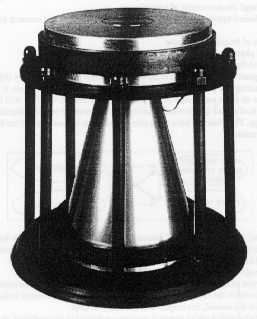
Near the bottom:
Bending wave loudspeakers
Loudspeaker - Wikipedia, the free encyclopedia
activeaudio
BENDING WAVE TECHNOLOGY
Welcome
An externally hosted image should be here but it was not working when we last tested it.
https://test.lightspeed-tek.com/(S(0h4zf545kgcuh2vngayxm02f))/default.aspx?id=360&
MCQ Hybrid Ceiling Speaker
The MCQ's hybrid combination of flat-panel and cone speaker technology delivers clear audio, excellent sound distribution and high speech intelligibility.
An externally hosted image should be here but it was not working when we last tested it.
https://test.lightspeed-tek.com/(S(0h4zf545kgcuh2vngayxm02f))/default.aspx?id=360&
NXQ Bending Wave Wall Speaker NXQ Flat-panel Wall Speaker
The NXQ is ideally suited for classrooms with ceilings that are higher than 9 feet. Based on bending wave physics, this speaker provides superior speech intelligibility.
An externally hosted image should be here but it was not working when we last tested it.
DECWARE - Radial Speaker Project

Near the bottom:
Bending wave loudspeakers
Loudspeaker - Wikipedia, the free encyclopedia
Bending wave transducers use a diaphragm that is intentionally flexible. The rigidity of the material increases from the center to the outside. Short wavelengths radiate primarily from the inner area, while longer waves reach the edge of the speaker. To prevent reflections from the outside back into the center, long waves are absorbed by a surrounding damper.
activeaudio
BENDING WAVE TECHNOLOGY
Welcome
Our first products are a white board panel & a magnetic panel where any item can be prepared to be placed according to client requirements. Intended for any application where the written word can be enhanced with any form of audio.
An externally hosted image should be here but it was not working when we last tested it.
Last edited:
One characteristic bending wave speakers have which very few other designs can manage is that they're reasonably close to being a spherical sound source....................................
The relatively uniform sound radiation from these speakers leads to one of the big marketing claims for NXT technology. That is that these speakers have no "sweet spot" - no small area where the listener has to be in order to get a really good stereo illusion, with a point-to-the-instruments soundstage.
This is true enough, but the flipside of it is that there isn't any place you can sit in the sound field from these flat panel speakers in which you'll get as clear a stereo image as you can get from good conventional speakers that've been set up well.
The more enthusiastic marketers make a positive out of this, by saying that the speakers don't have no sweet spot, but in fact have a huge one. There's a large area in which they sound their best, the place where speakers sound their best is the sweet spot, ta-dah.
Well, OK, fine. But there's still no sharp-stereo listening location. Bending wave flat panels just don't ever sound as "sweet", in this sense, as conventional "point source" speakers.
Because of this, some people describe the sound from bending wave panels as "unclear" or "muddy". Don't take that to mean that it's muffled. It's not. The S150 satellites have decent frequency balance and perfectly good highs, at least by multimedia speaker standards. But if you're looking for a pin-sharp soundstage, you're not going to get it.
I assume this was taken from a review of that small
satellites ...
One cannot audition one example of bending wave
loudspeakers and judge the whole principle as there
are large differences between concepts like in
conventional speakers too.
In most currently available designs, the challenges
resulting from using bending waves for high quality
sound reproduction have not even been fully accepted
by the designers.
And there are many challenges:
- How to achieve sufficient modal density for wideband
(or fullrange) operation
- How to deal with coincidence frequency of the panel
material used:
Having the coincidence frequency within the audible
range is most common for the more rigid panel types,
having it above the audio range is more common for
the less rigid types.
- How to achieve a decay that is comparable to
a high quality conventional speaker or even ESL.
Especially that last point is crucial, since that
"relatively uniform sound radiation" seems to rely
on modes being "pseudo randomly" distributed over
a panel and for this reason some designers think
it being necessary for the panel to "ring like a bell".
It is not. But with a speaker that rings you will not
have a good impulse response, you will not have
a balanced frequency response and the long decay
will indroduce a "foggy" quality to the reproduction.
At the coincidence frequency - where bending waves
on the panel have same propagation speed as sound
in air - the panel changes radiation efficiency and
preferred direction of radiation. That is an effect
which does serious harm to any reproduction if it is
not addressed consequently. Below coincidence
wave propagation is slower that in air and above it
is faster ...
Designs having the coincidence far above the audio
range circumvent that problem, but are on the
other hand endangered to having non even sound
distribution in the highs, which may cause beaming
like with conventional wide range concepts.
---
OK, even if we assume an "ideal" panel form
Bending Wave Loudspeaker, where those problems
have been tackled somehow, there are some
restrictions in placement and stereo imaging.
If the designer wants some controled directivity,
he will have to indroduce it by design like in any
conventional speaker. Most designs - as said before -
do not even address controled directivity, they just
use a panels given "wide radiation".
There seems to be a general tradeoff between
"spacious, no sweetspot" and "pinpoint localization
of phantom sources". That tradeoff is not specific
to bending wave transducers on the one hand.
On the other hand a large panel form bending wave
transducer will have a phase decorellation which
is getting higher with larger off axis angles.
That means, if you want rather sharply localized
phantom images, you will have the speaker to be
directed with their "coherent axis" to the listener.
That decorrelation effect is what makes the reproduction
less prone to inroom reflections and comb filtering by
near walls ...
The advantage is, that you may leave the "preferred seat"
and there is normally no coloration of the sound, but
localization looses "sharpness" when leaving that
"high corellation zone".
With a good panel form Bending Wave Loudspeaker,
there is an astonishingly smooth transition, from the
"preferred listening zone" to the "easy listening
zones" in the room. Depth and involvement stays, but
localization of phantom sources will fade out softly
in the "easy listening" areas. This is how my own
speakers do it at least.
---
A remark on imageing:
One may think about, whether "pinpoint lozalization"
having a nearly point source will give "realistic" imaging,
since it also causes artefacts in the room, like hard
early reflections etc.
That kind of imaging a (close to) point source radiator
can give, may itself be an artefact to some extent
... and i must admit that i never had such an
imaging situation in a concert hall e.g. , which would
be comparable to omidirectional point sorces in a small
room.
What was missing at home with most speakers was not
only localization, but also depth, stability of the auditory
scene with respect to changing the seat. Envelopment was
missing too.
And all that i'd like to have in a usual room, which serves
as a living room and is normally not treated like a studio's
control room.
But just using bending wave technology does not solve
all the problems in itself. A high quality speaker based
on bending waves is a damned tricky thing ...
Kind Regards
The relatively uniform sound radiation from these speakers leads to one of the big marketing claims for NXT technology. That is that these speakers have no "sweet spot" - no small area where the listener has to be in order to get a really good stereo illusion, with a point-to-the-instruments soundstage.
This is true enough, but the flipside of it is that there isn't any place you can sit in the sound field from these flat panel speakers in which you'll get as clear a stereo image as you can get from good conventional speakers that've been set up well.
The more enthusiastic marketers make a positive out of this, by saying that the speakers don't have no sweet spot, but in fact have a huge one. There's a large area in which they sound their best, the place where speakers sound their best is the sweet spot, ta-dah.
Well, OK, fine. But there's still no sharp-stereo listening location. Bending wave flat panels just don't ever sound as "sweet", in this sense, as conventional "point source" speakers.
Because of this, some people describe the sound from bending wave panels as "unclear" or "muddy". Don't take that to mean that it's muffled. It's not. The S150 satellites have decent frequency balance and perfectly good highs, at least by multimedia speaker standards. But if you're looking for a pin-sharp soundstage, you're not going to get it.
I assume this was taken from a review of that small
satellites ...
One cannot audition one example of bending wave
loudspeakers and judge the whole principle as there
are large differences between concepts like in
conventional speakers too.
In most currently available designs, the challenges
resulting from using bending waves for high quality
sound reproduction have not even been fully accepted
by the designers.
And there are many challenges:
- How to achieve sufficient modal density for wideband
(or fullrange) operation
- How to deal with coincidence frequency of the panel
material used:
Having the coincidence frequency within the audible
range is most common for the more rigid panel types,
having it above the audio range is more common for
the less rigid types.
- How to achieve a decay that is comparable to
a high quality conventional speaker or even ESL.
Especially that last point is crucial, since that
"relatively uniform sound radiation" seems to rely
on modes being "pseudo randomly" distributed over
a panel and for this reason some designers think
it being necessary for the panel to "ring like a bell".
It is not. But with a speaker that rings you will not
have a good impulse response, you will not have
a balanced frequency response and the long decay
will indroduce a "foggy" quality to the reproduction.
At the coincidence frequency - where bending waves
on the panel have same propagation speed as sound
in air - the panel changes radiation efficiency and
preferred direction of radiation. That is an effect
which does serious harm to any reproduction if it is
not addressed consequently. Below coincidence
wave propagation is slower that in air and above it
is faster ...
Designs having the coincidence far above the audio
range circumvent that problem, but are on the
other hand endangered to having non even sound
distribution in the highs, which may cause beaming
like with conventional wide range concepts.
---
OK, even if we assume an "ideal" panel form
Bending Wave Loudspeaker, where those problems
have been tackled somehow, there are some
restrictions in placement and stereo imaging.
If the designer wants some controled directivity,
he will have to indroduce it by design like in any
conventional speaker. Most designs - as said before -
do not even address controled directivity, they just
use a panels given "wide radiation".
There seems to be a general tradeoff between
"spacious, no sweetspot" and "pinpoint localization
of phantom sources". That tradeoff is not specific
to bending wave transducers on the one hand.
On the other hand a large panel form bending wave
transducer will have a phase decorellation which
is getting higher with larger off axis angles.
That means, if you want rather sharply localized
phantom images, you will have the speaker to be
directed with their "coherent axis" to the listener.
That decorrelation effect is what makes the reproduction
less prone to inroom reflections and comb filtering by
near walls ...
The advantage is, that you may leave the "preferred seat"
and there is normally no coloration of the sound, but
localization looses "sharpness" when leaving that
"high corellation zone".
With a good panel form Bending Wave Loudspeaker,
there is an astonishingly smooth transition, from the
"preferred listening zone" to the "easy listening
zones" in the room. Depth and involvement stays, but
localization of phantom sources will fade out softly
in the "easy listening" areas. This is how my own
speakers do it at least.
---
A remark on imageing:
One may think about, whether "pinpoint lozalization"
having a nearly point source will give "realistic" imaging,
since it also causes artefacts in the room, like hard
early reflections etc.
That kind of imaging a (close to) point source radiator
can give, may itself be an artefact to some extent
... and i must admit that i never had such an
imaging situation in a concert hall e.g. , which would
be comparable to omidirectional point sorces in a small
room.
What was missing at home with most speakers was not
only localization, but also depth, stability of the auditory
scene with respect to changing the seat. Envelopment was
missing too.
And all that i'd like to have in a usual room, which serves
as a living room and is normally not treated like a studio's
control room.
But just using bending wave technology does not solve
all the problems in itself. A high quality speaker based
on bending waves is a damned tricky thing ...
Kind Regards
Last edited:
I agree with the quoted statement above, and with everything else you wrote too.That kind of imaging a (close to) point source radiator
can give, may itself be an artifact to some extent
... and i must admit that i never had such an
imaging situation in a concert hall e.g. , which would
be comparable to omidirectional point sources in a small
room.
I did have to look up the phrase "coincidence frequency", thank you for trying educate folks like me. There are many things I can work with and understand at a level other than found in written language or math. Terms like "coincidence frequency" do a lot to help define or expand what I actually know rather than what I feel.
Even though in many respects bending wave speakers I've heard do sound and present sound in a more realistic way than conventional speakers, I have to wonder about their acceptance factor. What I mean is; because they (in my opinion) present music more like a live event, will this hurt them in an era where many are "ear bud" people?
Take for instance the large corner horns of the 50's and 60's. They could load the room with sound much as a live event, and were very dynamic (again like live music) but these factors alone could not in the long run overcome their other shortcomings with the greater buying public. The pinpoint imaging of conventional loudspeakers was/is just to novel and entertaining for corner horns to compete with. Could bending wave speakers be facing the same challenge?
Do people choose their news station and newspapers because they are the most accurate or fair? Or do they choose it because it presents news in a manner which reinforces our own biases?
My bias is towards live music, but live music lacks pinpoint imagery. I will have to give up pinpoint imagery, something I've grown to like and crave in my home stereo system. How many will be willing to wean themselves and get off the pinpoint imaging teat?
They sell a lot of food products with artificial flavoring, coloring and extra salt (to unnatual levels), the people who consume these products tend to dislike the real thing (in my opinion).
Fiber and pulp removed, no thanks - I'll take the real thing.
Last edited:
- Status
- This old topic is closed. If you want to reopen this topic, contact a moderator using the "Report Post" button.
- Home
- Loudspeakers
- Planars & Exotics
- Wave Speakers - How do they work?
